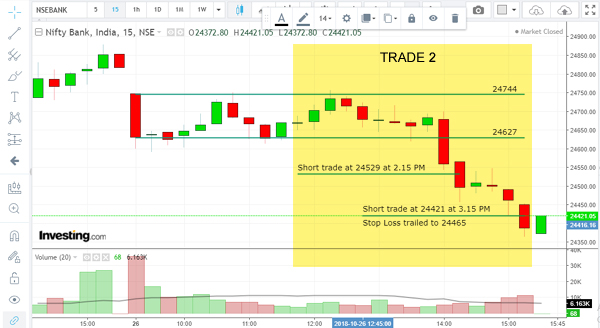No matter of how much science and art you may throw into it, trading is a risky game.
Even professional traders who play with crores, and have access to very expensive trading software, have failed many times or have gone bust.
Therefore, it makes sense to understand how much capital you should allocate to trading, and how you should manage risk.
A: ALLOCATION OF TOTAL TRADING CAPITAL
If you are a newbie to trading, do not allocate more than 10% of your total stock market investment capital to trading.
If you are somewhat experienced in trading, you can consider allocating 15% to 20% of your total investment capital to trading.
And that’s it – no more.
Understand that equities are an asset and that your investment will appreciate steadily over the long run so long you invest in quality stocks.
Trading should be regarded as a hobby by newbies and amateur traders – at least util they get enough experience and confidence to allocate a higher percentage to trading.
Of course, professional traders allocate a higher percentage, and therefore you should first judge your trading skills before making an allocation.
B: ALLOCATION OF CAPITAL PER TRADE
Let us now assume that your total investment capital is Rs 10 lakhs and you have decided to allocate Rs 1 lakh (10%) to trading.
You already know by now that trading is risky and that if you bet this Rs 1 lakh capital on 1-2 trades, you may end up losing it in quick time.
Therefore, let’s say you want to spread it over 10 trades to gauge your success ratio.
Assuming 60% wins, the worst case scenario will be (W=Win, L=Lose):
LLLLWWWWWW
… and the best case would be
WWWWWWLLLL
The reality would lie somewhere in between.
THEREFORE, it is prudent to risk your trading capital @ 10% per trade or if you are extremely confident, 20% per trade (at the max).
A: RISK REWARD RATIO (RRR)
Let us continue with the example from above and assume that we want to risk Rs 10,000 per trade.
We have assumed that the possibility of winning is 60%, which is a fair estimate so long we know technicals.
So, for the first trade our maximum risk is Rs 10,000.
Now what should our reward be?
If we are risking Rs 10,000, then our reward should be greater than the risk undertaken, isn’t it?
So, let us say, we want our reward too be Rs 20,000.
In this case the RRR (Risk Reward Ratio) is 1:2 (Risk 10,000, Expected Reward 20,000).
Some traders work at 1:3 RRR, which is considered optimal.
However, 1:2 is a reasonable and realistic ratio.
A: HOW TO PLAY THE RISK REWARD RATIO (RRR)
Let’s say that you want to enter into a Bank Nifty day trade and that you are prepared to risk Rs 2,000.
Your standard Risk Reward Ratio is 1:2 – this means you are targeting a gain of Rs 4,000 for the trade and a maximum risk of Rs 2,000 for that trade.
The setup used in this example is our 15 Minute Price Action strategy.
As per our 15 minute setup, a short sell was triggered in the Bank Nifty on 26-10-18 at around 2.20 PM when the BNF decisively crossed below the support line.
At that time BNF was around 24529.
Let’s say we shorted 2 lots (40 units)
Our Risk Reward Ratio is 1:2, and the maximum amount we are prepared to lose per trade is Rs 2,000.
Therefore, the Stop Loss should be set at 24,579 (24529 selling price, 24579 SL implies Rs 50 loss on 40 units = Rs 2,000).
We got to be very strict about the SL and exit the trade when the SL hits without getting emotional. We also know that we will get other chances to make money.
Our profit target is Rs 4,000. In this trade, the BNF continued to drop, which was a good thing for us.
It fell all the way to 24370.
However, our strategy should be to safe guard profits.
As BNF slipped to 24500, the best thing to do would be to trail Stop Losses to 24465, thereby ensuring that we we make a minimum profit of Rs 64 per unit (24529 less 24465).
Once the stop loss is trailed we can sit back and relax because even if it hits, we are making a gain of Rs 2560.
In the chart above, if we had not trailed our Stop Loss, we would have realized the targeted Rs 4,000. BUT it’s always a wise move to trail.
Remember that profit is a thief – arrest it. Loss is a disease – lose it.
Also know that the theoretical RRR may not work out the way it is planned.
Sometimes when there’s any news the stock can move violently either way. In such a case, your SL will protect your capital, and if the news is in your favour, you can even make 1:2+ RRR.
This is how you must think about allocating capital to trading, allocating capital per trade and managing risk/reward.
You must be extremely disciplined in your trading. Once you set the rules, stick by them. If you deviate from yoour plan, you will start making one mistake after another,
Finally, remember this is not science – it is actually common sense. So goo ahead and practice it.



Very well explained…
Nice one. Simple and easy to adopt, but discipline as you said is very important. Thanks for your all artiles.
very well explained thanks.